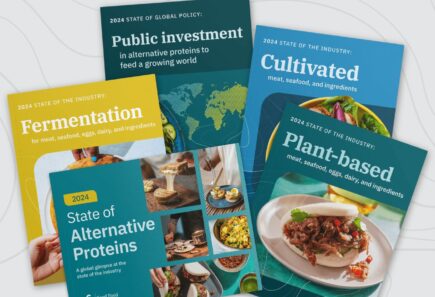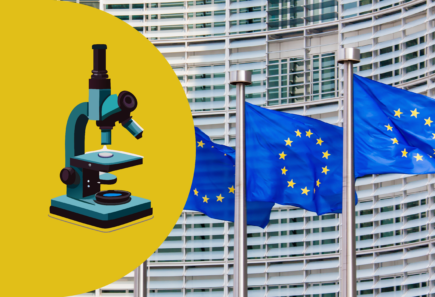What is precision fermentation?
Everything you need to know about how this innovative process can enhance alternative proteins.

Diversifying Europe’s protein supply will be essential for delivering on our climate targets, boosting food security and expanding nature-friendly farming. Plant-based foods will play a central role in a diversified food system – but to deliver on their potential, plant-based meat, seafood, eggs and dairy will need to look, cook and taste just like the foods we eat today. Precision fermentation has incredible potential to unlock the flavour, texture, nutrition and functionality of animal products by producing key proteins and ingredients efficiently and sustainably.
What is precision fermentation?
Precision fermentation is a process that has been used for decades in food production to produce common ingredients such as rennet (used in cheesemaking) and citric acid (a common preservative used in conventional meat products, and as an emulsifier in dairy products). In scientific terms, it is a branch of engineering biology that uses the natural abilities of certain microorganisms like yeast to produce high-quality, low-cost ingredients sustainably and quickly.
Scientists, startups and companies are beginning to use precision fermentation to produce ingredients like heme, an easily digested source of iron that can bring a ‘meaty’ taste to plant-based foods. They are also producing egg and dairy proteins that can enhance plant-based baked goods and cheese, as well as sustainable palm oil, and chocolate and coffee compounds.
How does precision fermentation work?
Precision fermentation has been used for decades to produce ingredients like low-cost rennet for cheesemaking, and is now being used to make next-generation alternative protein ingredients.
Similar to how traditional fermentation is used to produce alcohol when brewing beer and wine, precision fermentation uses microorganisms like yeast to produce ingredients ranging from palm oil to dairy proteins.
First, microorganisms are given biological instructions that tell them how the target ingredient is made – which, for alternative protein applications, could be a flavour molecule like heme or a protein like whey.
They are then added to a warm fermentor and fed sugars, which the microorganisms then convert into the desired ingredients and release into the fermentor.
The water in the fermentor is then removed and the ingredients are filtered out to be used as part of a plant-based recipe – for example, to add a meaty flavour to a burger or stretchiness to plant-based cheese.

What is the environmental footprint of precision fermentation?
Existing studies suggest that precision fermentation egg and dairy proteins could cause 70% less greenhouse gas emissions, while using 95% less land and 80% less water than the same proteins made through animal agriculture. Precision fermentation also leads to far less nutrient pollution and eutrophication, as the waste produced by industrial agriculture is responsible for significant biodiversity loss in several European countries, with aquatic ecosystems particularly hard-hit.
The use of precision fermentation to produce alternative protein ingredients is at an early stage and a small scale, so more research will be needed to determine the exact environmental impact of commercial production – but the process is incredibly efficient.
Environmental impact savings of dairy and egg proteins made using precision fermentation compared to conventional production
Precision fermentation in Europe
Europe is home to leading researchers and startups in the field of precision fermentation, and public funding is beginning to grow at both the national and EU levels. However, governments need to invest more to expand research and innovation, and build the infrastructure needed to help precision fermentation ingredients reach the scales necessary to enter the mainstream.

In 2022, the Dutch government announced €60 million of public funding to support the formation of an ecosystem around precision fermentation and cultivated meat. The package represents the world’s largest-ever public investment in cellular agriculture.

In 2023 and 2024, the UK government invested in several multi-million-pound research centres, which will develop foods such as sustainable palm oil through precision fermentation.

In 2023, the regional government of Catalonia in Spain invested €7 million in a Center for Innovation in Alternative Proteins (CiPA), which will help alternative protein businesses in plant-based and fermentation-made foods scale up production.

The European Commission’s EIC Accelerator will invest €50 million in 2024 into foods made from precision fermentation and algae.
Can you buy precision fermentation products in Europe?
While the process has been used to make common ingredients for decades, using precision fermentation to produce proteins and ingredients to enhance plant-based foods is relatively new, meaning products need to go through the EU’s Novel Foods regulatory framework before they can be sold. Once EU regulators approve a new fermentation product, it can be sold across all 27 member states. The approval process will include a thorough and evidence-based assessment of the safety and nutritional value of the food and is estimated to take at least 18 months.
Other European governments outside the EU have similar regulatory frameworks in place for the assessment and authorisation of novel foods. Meanwhile, some European precision fermentation companies have already secured regulatory approval in other global markets, including Singapore.
Latest stories on precision fermentation

Learn more
Learn more about the science, business and policy of fermentation in Europe








